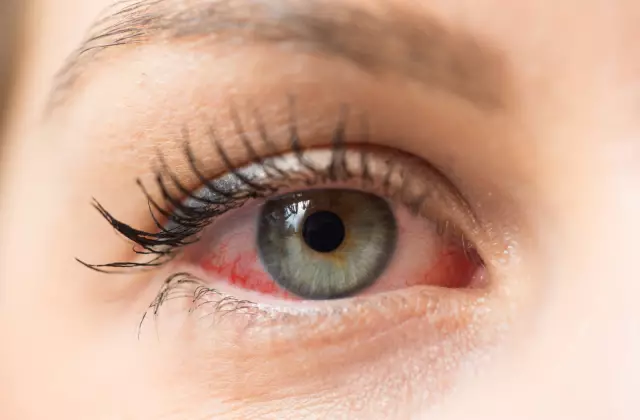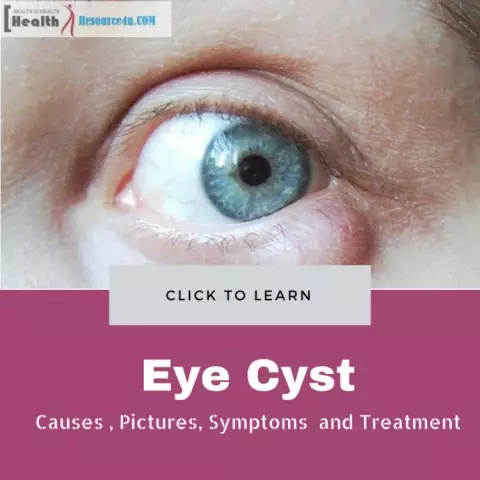- Author Rachel Wainwright [email protected].
- Public 2023-12-15 07:39.
- Last modified 2025-11-02 20:14.
10 causes of eye redness
The sclera (protein) and the mucous membrane of the eye are equipped with blood vessels, the task of which is to saturate the nervous tissues of the organ with nutrients and oxygen. In a normal state, the vessels are practically invisible, however, when they expand (due to thinning of the walls), they become visible, since they stain the sclera red. Often, red eyes are a signal of the presence of some kind of trouble in the body, which can be caused by both external irritants, allergens, and diseases that need to be investigated and treated. Consider why this kind of violation occurs.
External stimuli
The physical factor is a common and not always harmless cause of eye redness. Constant external exposure can lead to permanent visual impairment. As a result of the influence of the sun, gusts of wind, frost, a slight and short-term redness of the eyes appears, which, as a rule, disappears within an hour. In addition to unfavorable weather conditions, city smog, cigarette smoke, foreign objects in the air (dust, grains of sand, specks, animal hair, etc.), as well as various aerosols can affect the mucous membrane of the eye. In these cases, the rate of disappearance of redness is individual and depends on the amount of damage.
In addition, trauma (caused by a hand, stick, other object) or a burn can cause redness, and in such situations, if there is severe inflammation, it is recommended to consult a doctor.

Source: depositphotos.com
Eye strain and fatigue
Eye fatigue often causes a failure in their normal functioning, accompanied by an unpleasant feeling of dryness, soreness, redness. It occurs, as a rule, with prolonged concentration on an object: a page of a book, a TV screen, a computer monitor, etc. It increases the burden on eyesight and improper illumination during work (too bright or, on the contrary, dim light).
Eyes get tired quickly as a result of lack of sleep or lack of sleep, as well as mental stress, during which intraocular pressure rises. If excessive stress occurs for a significant period, it can lead to myopia (nearsightedness), and redness of the eyes can become chronic.

Source: depositphotos.com
Alcohol
Alcohol intake is another common cause of vasodilation, not only in the eyes, but also in the skin and internal organs. A large dose of alcohol provokes the release of norepinephrine and renin, which increase blood pressure, into the bloodstream, which is why drinkers often have a capillary mesh on the whites of the eyes, and in some cases hemorrhages into the eyeball occur.

Source: depositphotos.com
Conjunctivitis
Redness of the mucous membrane of the eye is one of the symptoms of conjunctivitis of any nature (bacterial, viral, herpetic, allergic, etc.). Along with inflammation in the disease, irritation, burning, lacrimation, increased eye fatigue, as well as eyelid edema and photophobia can be observed. Conjunctivitis also occurs as a result of poor hygiene, that is, the use of other people's handkerchiefs, towels, occasional hand washing, and can be transmitted not only by contact, but also by airborne droplets (viral conjunctivitis). Treatment of the disease depends on its form, but in any case, to reduce the severity of inflammation, it is useful to rinse the eyes with fresh tea leaves or chamomile decoction.

Source: depositphotos.com
Allergic reaction
The eyes are a sensitive organ that is easily affected by irritating factors, one of which is allergens. Substances that provoke a strong response of the mucous membrane of the eye can be found in cosmetics, household chemicals, medicines, plant pollen, wool, animal feathers, as well as house dust, which usually contains molds and foreign bodies. In some cases, an allergic reaction can occur to impermeable contact lenses and lens rinses. Elimination of redness in such situations, as a rule, occurs with the help of an antiallergic agent used as directed by a doctor.

Source: depositphotos.com
Corneal inflammation
Redness of the eye (along with edema, tearing, decreased transparency of the cornea) is a characteristic symptom of corneal inflammation, or keratitis. This disease has a different nature: it is caused by colds, viral diseases, parasitic fungi, as well as corneal injuries. With inadequate or inadequate therapy, keratitis can lead to loss of vision, therefore it must be treated in a hospital under the supervision of a doctor.

Source: depositphotos.com
Hypertension
Arterial hypertension (hypertension) is one of the common diseases that can affect the condition of the retina. The most common retinal angiopathy is an increased branching and tortuosity of veins, due to which small arteries become visible, as well as point hemorrhages in the membrane of the organ. Angiopathy is characteristic of the 1st (unstable) stage of hypertension and, as a rule, resolves with the correct selection of antihypertensive drugs.
Angiopathy at the 2nd stage of hypertension can develop into angiosclerosis (thickening and narrowing of the lumen of blood vessels), which in some cases leads to their complete blockage. Along with redness of the eyes, signs of the disease are flies, dark spots before the eyes, itching, pain in the eyes. Eye problems in severe hypertension are sometimes accompanied by edema, nasal and ear hemorrhages, and blood in the urine. It is important to remember that vascular damage can affect the optic nerve and lead to loss of vision, therefore, the disease cannot be left without medical supervision.

Source: depositphotos.com
Diabetes
Damage to blood vessels, leading to redness of the eyes, in diabetes mellitus occurs due to regular fluctuations in blood glucose levels characteristic of the disease. Vascular problems in diabetes, as in hypertension, cause the development of angiopathy, which in more severe cases is replaced by retinopathy, that is, opacity and destruction of the retina. To prevent vision loss, it is important to control blood sugar and cholesterol levels and diagnose visual impairments as early as possible, paying attention to the symptoms of the disease (reddening of the sclera, vascular network, hemorrhages, dark spots before the eyes, etc.).

Source: depositphotos.com
Dry eye syndrome (xerophthalmia)
Xerophthalmia is one of the causes of redness, dryness, irritation, itching in the eyes. They arise due to insufficient production of tear fluid in some diseases (thyroid pathologies, lymphoma, Sjogren's disease). Symptoms of the disease are similar to those of conjunctivitis, however, the treatment in this case consists in eliminating common diseases or prescribing eye drops that supplement or replace natural lacrimation.

Source: depositphotos.com
Glaucoma
Innocuous redness of the eyes can be a symptom of glaucoma, a disorder caused by increased intraocular pressure. This disease often threatens with deterioration or complete loss of vision. It is important to remember that an acute attack of glaucoma (it is usually accompanied by nausea, vomiting, decreased heart rate, photophobia) requires urgent medical attention to urgently lower intraocular pressure with medication. In some cases, glaucoma develops slowly, manifesting itself with redness, the appearance of rainbow circles in front of the eyes, deterioration of peripheral vision (a person does not see objects located on the side), the appearance of dark spots in front of the eyes, therefore, if the above symptoms appear, it is necessary to visit an ophthalmologist in time and undergo an examination.
How to treat eye redness
Diseases such as hypertension, allergies, conjunctivitis and corneal inflammation require treatment by a specialized physician - therapist, allergist or ophthalmologist. However, the most common cause of eye redness and dry eye syndrome is fatigue and prolonged overstrain. We are used to brushing off the problem of fatigue, not a disease, and okay. In fact, this problem is no less serious than the others, but its consequences are a little more distant. But after all, not everyone will go to the doctor with a complaint that the eyes get tired, and doctors advise in such cases to strain the eyes less and give them rest more often. People who are familiar with the problem of tiredness and dry eyes firsthand shrug their shoulders - despite the rationality and simplicity, following this advice is not so easy, and on some days it is completely impossible. What to do?
Ophthalmologists have developed drugs, the general name of which is "artificial tear", since they perform the same function as the tear fluid - they protect the ocular surface from drying out. Let's consider them in more detail using the example of three popular tools.
| A drug | Act | Indications |
| Cationorm (cationic emulsion) |
Moisturizes the cornea, restores three layers of tear film, relieves dry eyes and discomfort even with prolonged eye strain, and prevents the development of dry eye syndrome. Does not contain preservatives, can be used with lenses. |
Severe dryness of the eyes (including morning), discomfort in the eyes; including when: - prolonged wearing of contact lenses (more than 10 hours a day, more than 5 days a week and / or more than 6 months); - other eye diseases (allergic conjunctivitis, blepharitis, glaucoma); - long-term use of hormonal drugs (hormone replacement therapy during menopause, taking oral contraceptives). |
| Ocutiars (ultra-high molecular weight hyaluronic acid eye drops) |
Quickly eliminates eye fatigue after prolonged visual stress; eliminates discomfort after manipulations on the cornea. Stored for 6 months after opening the bottle. Can be used with contact lenses. |
- dry eyes, appearing by the end of the day after prolonged stress, computer (office) syndrome in office workers, motorists, people who often make flights, students, etc.; - to facilitate putting on and taking off lenses; - to eliminate discomfort, dry eyes in the period 6 months after eye surgery (cataract removal, LASIK, PRK). |
| Oftagel (eye gel with maximum carbomer concentration) |
Provides long-term hydration, prevents watery eyes. Does not require frequent use, it is enough to apply once a day (at night). |
- dry and tired eyes in the absence of the ability to instill eye drops several times a day; - lacrimation. |
YouTube video related to the article:

Maria Kulkes Medical journalist About the author
Education: First Moscow State Medical University named after I. M. Sechenov, specialty "General Medicine".
Found a mistake in the text? Select it and press Ctrl + Enter.






